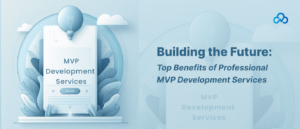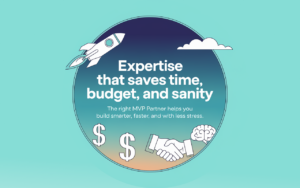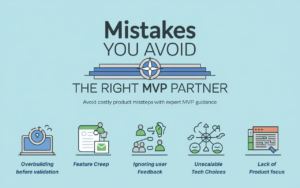Building the Future: Top Benefits of Professional MVP Development Services

Speed isn’t what it used to be. Sure, moving fast still matters, but in today’s startup landscape, speed without validation just leads to expensive mistakes. Launching quickly is only impressive if you’re building something people actually need. That’s where minimum viable product development comes in. It’s not just a framework. It’s a mindset. Instead of trying to perfect every feature before your first user even sees it, you launch small, learn fast, and iterate based on what actually happens, not what you hoped would happen.
It’s honestly kind of refreshing. Rather than throwing months (or worse, your entire budget) at an untested idea, founders are partnering with a professional MVP software development agency to build smarter from day one. And when done right, that MVP doesn’t just get you to market, it becomes the launchpad for something that grows the right way.
In this article, we’ll unpack why MVP development services have become a go-to strategy for smart teams, what they actually deliver behind the scenes, and how they help early-stage startups make faster decisions, without betting everything on a hunch.
Smart Startups Don’t Build Everything, They Build the Right Thing First
It’s tempting to want your product to feel “complete” before you show it to anyone. That instinct to polish everything before launch? Pretty common, and also one of the fastest ways to waste time. Founders who’ve done this before usually take a different route. Instead of building out every idea on the whiteboard, they ask a better question: what’s the smallest version of this that’s still actually useful?
That’s where minimum viable product development earns its keep. It helps you narrow the focus, block out the noise, and stop overthinking. You build something simple, but meaningful, and let users show you what’s working and what’s not. And here’s the part a lot of people miss: users rarely want all the extras anyway. They want one thing that works well. Something clear, helpful, and fast. A good Product MVP gives them that, without the clutter.
Teaming up with the right MVP software development agency makes this process easier. They’ll help you cut what doesn’t matter, ask the uncomfortable questions early, and steer your energy toward building what’s essential, not just what looks impressive on paper.
At this stage, it’s not about how much you can build. It’s about building the right thing, and using that as the foundation to move forward with clarity and momentum.
Expertise That Saves Time, Budget, and Sanity
Let’s face it, building something from scratch with limited resources is already tough. Trying to do it without the right help? That’s where things get messy fast.

This is why more early-stage teams are working with professionals who specialize in minimum viable product development. It’s not just about hiring coders. It’s about partnering with people who’ve done this before, people who know how to help you avoid the traps most first-time founders fall into.
Good MVP teams don’t just ask what you want to build. They help you figure out why you’re building it in the first place. They poke holes in vague assumptions, simplify where things are getting bloated, and offer smarter ways to reach the same outcome with fewer steps (and less stress).
Here’s what that kind of support actually gets you:
-
A faster path to launch. You’re not stuck rethinking things mid-project or starting over because something wasn’t scoped right from the beginning.
-
Tighter control over costs. The focus stays on must-haves, not wish lists.
-
More mental clarity. When someone else is managing the process and the technical details, you’re free to think big without getting lost in the weeds.
And most importantly? You’re not doing it alone. You’ve got a team keeping things on track, keeping the build lean, and helping you stay sane through all the moving parts.
Because sometimes, it’s not just about what you build, it’s about who’s helping you build it.
Real Users > Hypothetical Buyers
You can brainstorm for weeks. Run surveys. Even sketch out detailed personas. But until someone actually uses your product, you’re still just guessing.
That’s the beauty of minimum viable product development, it gets you out of theory and into reality, fast.
When you launch a lean, usable version of your product, you stop relying on assumptions. You start learning from how people actually interact with what you’ve built. You notice where they click, what they ignore, where they hesitate, and where they bounce.
And that’s not failure, it’s feedback. It’s insight you can use to adjust before wasting time and budget on features no one ends up caring about.
The best MVP development teams know how to bake this into the process. They’ll help you get early feedback loops going without overwhelming you with dashboards or analytics jargon.
Here’s what that usually looks like:
-
You see what resonates and what gets skipped. People show you, without saying a word, what matters to them.
-
You fix issues early, not after launch. Confusing flows or missing logic pop up fast when real people use your product.
-
You get a roadmap grounded in reality. Every improvement comes from data, not guesswork or gut feelings.
-
You build trust. When early users see you responding to feedback, they feel heard, and they tend to stick around.
The point isn’t to get it perfect the first time. It’s to build something you can test, tweak, and improve while people are using it.
Because real progress doesn’t come from planning in a bubble. It comes from building something real and letting users shape where it goes next.
Get to Market Without Breaking the Product
Moving fast is great, until something cracks under pressure.
It’s easy to get caught up in speed. You want to ship, show progress, maybe even beat someone to market. But if you cut corners just to launch quickly, you might end up spending twice as long fixing everything afterward.
That’s where thoughtful minimum viable product development makes a huge difference. It’s not just about building fast, it’s about building something that actually works in the real world.
An experienced MVP team helps you get to market without the stress of breakdowns and hotfixes. Even if you’re launching with fewer features, the core is solid. The infrastructure is stable. And most importantly, it’s built to grow with you.
Here’s what that usually looks like:
-
Clean code that doesn’t fall apart. No hacky shortcuts that cause headaches later.
-
Scalable foundations. Even if your MVP is simple, it’s not a throwaway, it’s built with growth in mind.
-
Performance that holds up. Users don’t care if it’s version 1.0. If it’s slow or glitchy, they bounce.
-
Early testing to catch issues before launch. Better to find problems now than scramble later.
You shouldn’t have to choose between speed and stability. With the right partner, you can have both: a fast launch and a product that doesn’t break the moment real users show up.
Because at the end of the day, an MVP isn’t just about proving your idea, it’s about showing it can actually hold up when it counts.
Not Just Minimum Viable Product Development, Full Lifecycle Product Strategy
When people hear “MVP development,” they often picture a developer typing away to get something functional out the door. But the good ones? They bring a lot more to the table than just clean code.
A solid minimum viable product development team helps shape your entire early-stage product journey ,from sketching out ideas to refining the live version once users start giving feedback.
It’s not just about how fast they build, it’s about what they help you build, and why.
Here’s what full-scope MVP services typically include:
-
Product discovery workshops.
Before anything gets designed, the team helps you define the problem, align on your goals, and figure out who you’re actually building for. -
UX/UI design and user flows.
They don’t just make things look good, they make sure users can move through the product intuitively, without getting stuck. -
Feature prioritization and roadmap support.
You’ll be challenged to keep only what matters in version one, with a clear plan for what comes next. -
Post-launch iteration.
After the MVP is live, they stick around to help you understand the data and decide how to improve based on what real users are doing.
In short, they don’t treat your MVP like a finish line. They treat it like the beginning of something better, something built to grow over time.
When you work with a team that gets both the build and the bigger picture, you’re not just checking boxes. You’re setting your product up for smarter, faster decisions down the road.
Validation That Attracts Investors
Having a great idea is one thing. Showing that people are actually using it? That’s what gets investors to take notice.
In early-stage fundraising, minimum viable product development gives you something no pitch deck can fake, proof. Proof that there’s a real need, that your team can execute, and that users are already engaging with what you’ve built.
Founders often assume they need a polished, full-featured product to raise money. In reality, a lean but functional MVP that’s generating traction will do more to impress investors than any amount of theoretical planning.
Here’s why:
-
It shows you’ve moved past the idea stage.
You’re not just talking ,you’re shipping. That alone sets you apart. -
It proves people care.
Even modest early usage tells investors you’re solving a real problem. -
It demonstrates discipline.
Building lean shows you’re strategic with time, budget, and scope, something investors always look for. -
It gives you real metrics.
Retention rates, feature adoption, user feedback, this data is gold when pitching.
And when your MVP has been built with help from a seasoned team, it looks and feels professional too, which doesn’t hurt when you’re trying to build credibility.
Investors don’t need to see the final product. They need to believe in the path you’re on. With a tested, functional MVP in hand, that belief becomes a lot easier to earn.
Mistakes You Avoid with the Right MVP Partner
Going solo, or picking the wrong team, for your first product build? That’s where a lot of startups hit a wall.

Working with an experienced minimum viable product development partner doesn’t just help you move faster. It helps you avoid the classic mistakes that cost founders time, budget, and momentum.
Here’s what the right partner helps you steer clear of:
-
Overbuilding before validation.
Too many teams spend months developing features no one ends up using. A solid MVP partner will stop that before it starts. -
Feature creep.
Good MVP agencies know how to keep the scope tight, even when excitement tempts you to add “just one more thing.” -
Ignoring user feedback.
The right team sets up feedback loops from day one, and helps you use them to guide future decisions. -
Unscalable tech choices.
They won’t patch something together just to get it live. A real MVP partner builds with growth in mind. - Lack of product focus.
They’ll challenge your ideas when needed, helping you zero in on what really matters for launch, not what just sounds good.
It’s not about building a perfect product the first time. It’s about building something functional, testable, and learnable, and having people in your corner who’ve done it enough times to know where things usually go sideways.
Because sometimes, the smartest move isn’t knowing what to do. It’s knowing what not to do, and having a team that keeps you on track.
Building the Future, One Smart Launch at a Time
Let’s be real, building a product that matters is hard. And trying to do everything at once? That usually doesn’t help. The teams that figure it out tend to keep things simple early on.
That’s where minimum viable product development earns its keep. It’s not about doing less for the sake of speed, it’s about cutting through the noise. You build just enough to learn what’s actually useful, then take the next step with confidence.
Now, if you’re still wondering “what is MVP product thinking really about?”, it’s this: getting a real, usable version of your idea in front of people, then improving it based on what you learn. Not on what you assume.
And no, the best teams aren’t the ones building non-stop. They’re the ones who slow down when it matters, listen to feedback, and make smarter choices early, before it’s expensive to change direction.
A strong MVP software development agency makes all of this easier. They don’t just execute what you ask, they help you figure out what’s worth building in the first place. They’ll challenge you, simplify things when needed, and help you avoid going too wide too soon.
At this stage, every decision has weight. You’re not just shipping a product, you’re setting the tone for everything that follows. So, build what matters. Build what’s real. And build with a team that gets the bigger picture.
Because in the long run, it’s not about building the flashiest product. It’s about building something people actually want, and having the runway left to keep improving it.
Do you like to read more educational content? Read our blogs at Cloudastra Technologies or contact us for business enquiry at Cloudastra Contact Us